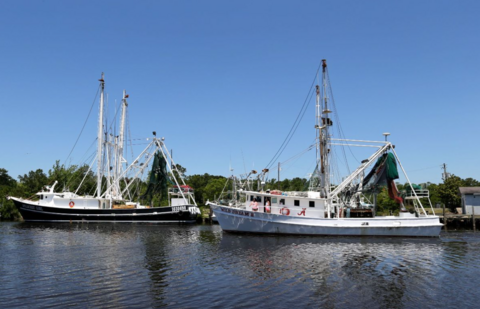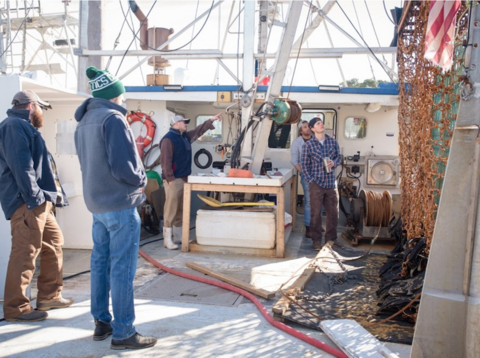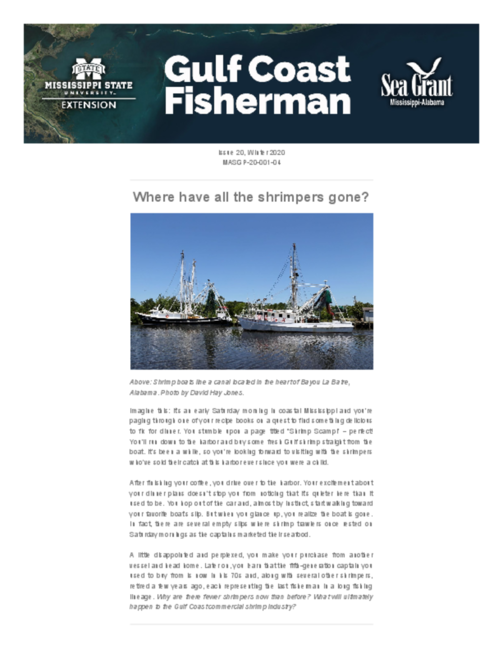Gulf Coast Fisherman Newsletter
Issue 20, Winter 2020
Where have all the shrimpers gone?

Imagine this: it’s an early Saturday morning in coastal Mississippi and you’re paging through one of your recipe books on a quest to find something delicious to fix for dinner. You stumble upon a page titled “Shrimp Scampi” – perfect! You’ll run down to the harbor and buy some fresh Gulf shrimp straight from the boat. It’s been a while, so you’re looking forward to visiting with the shrimpers who’ve sold their catch at this harbor ever since you were a child.
After finishing your coffee, you drive over to the harbor. Your excitement about your dinner plans doesn’t stop you from noticing that it’s quieter here than it used to be. You hop out of the car and, almost by instinct, start walking toward your favorite boat’s slip. But when you glance up, you realize the boat is gone. In fact, there are several empty slips where shrimp trawlers once rested on Saturday mornings as the captains marketed their seafood.
A little disappointed and perplexed, you make your purchase from another vessel and head home. Later on, you learn that the fifth-generation captain you used to buy from is now in his 70s and, along with several other shrimpers, retired a few years ago, each representing the last fisherman in a long fishing lineage. Why are there fewer shrimpers now than before? What will ultimately happen to the Gulf Coast commercial shrimp industry?
Graying of the Fleet
Commercial fishing looks a lot different today than it did previously – even just one generation ago. During the past 30 years, the average age of U.S. commercial fishermen has increased substantially, a phenomenon known as “graying of the fleet.” As older fishermen retire, young entrants are expected to take their place, but the number of entrants is dwindling to such an extent that the very survival of the U.S. commercial fishing industry is at stake.
Several factors are contributing to the lack of young people entering the industry. First, commercial fishing is a costly venture. Ideally, young entrants inherit fishing vessels and gear from their parents or grandparents; however, that’s not always the case. Even if young people are fortunate enough to start their fishing careers with vessels and gear already on hand, they often face slim profit margins due to a multitude of recurring expenses, including vessel upkeep, fuel, insurance, permits, safety training, and crew member wages. The low prices and high availability of imported seafood further decrease profits by forcing fishermen to keep prices low when marketing their catch (which is just one of many reasons why it’s so important to buy locally-harvested seafood!). Compounding all of the financial obstacles involved in entering the industry, commercial fishing is a hard way of life. It’s an around-the-clock job, it’s physically taxing, and it’s one of the most dangerous professions in the U.S. – second only to the logging industry! Moreover, it is difficult for people who are new to commercial fishing to learn the trade. Captains aren’t always willing to take on inexperienced workers because they have the potential to slow down the work (thereby causing loss of revenue) or even prompt safety concerns. All of these factors, among others, have resulted in a graying U.S. commercial fishing industry.
Fishermen Training Programs

Fishermen training programs represent a promising strategy for mitigating graying of the fleet because they provide critical infrastructure to encourage new entrants into the commercial fishing sector. Although different programs are unique from one another, they generally offer hands-on experience within the industry as well as safety training. Many programs are also able to connect entrants with experienced captains and crew members, who then serve as mentors for the entrants. If a given program has ample funding, it may provide stipends to the mentors in order to alleviate some of the pressure (i.e., time, energy) involved with mentorship. As an added benefit, fishermen training programs tend to reassure experienced fishermen’s trust in entrants because those who participate in these programs are better prepared for the industry.
A Guide to Fishermen Training Programs
Given the prevalence of graying of the fleet along all U.S. coastlines, we decided to collect information about existing commercial fishermen training programs around the country and compile the information into a guidebook. Seeing as recreational fishing, aquaculture, and stewardship activities are becoming increasingly popular, we included those types of training programs in the guidebook as well. Each guidebook entry contains the core features of a given program (name, location, organizer’s name and contact information), the year the program began, the duration, the cost, participation requirements, and other helpful details. We identified a total of 27 programs across the nation, most of which are located along the Atlantic and Gulf coasts. The number of commercial versus recreational programs is approximately the same, and some programs actually cater to both sectors. Surprisingly, although program activity spans from 1981 – present, more than half of the 27 programs were created during the past 5 years. This indicates that all major coastlines are making progress in implementing fishermen training programs to educate and recruit young entrants.
We thank our 2020 Mississippi State University Extension Apprentice, Kindall Calhoun from the University of South Alabama, for her hard work on this project. We hope our guidebook will serve as a useful resource for folks who are interested in starting a training program, improving upon an existing program, or simply learning more about fishermen training programs. If you’re interested in viewing a PDF of the guidebook, please click here!

I'm Marcus Drymon, an Assistant Extension Professor at Mississippi State University and a Marine Fisheries Specialist at Mississippi-Alabama Sea Grant. Amanda Jefferson, Matthew Jargowsky, and I are the Marine Fisheries Ecology Lab. We'd love to hear from you! Please reach out to us at marinefisheriesecology@gmail.com
Download
Filed Under
Authors
-
 Associate Extension Professor
Associate Extension Professor- CREC-Coastal Marine Ext Program
